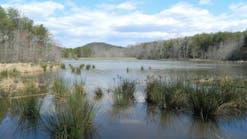The following is a transcript of the WaterWorld Weekly Newscast for the week of July 25, 2016. Watch the video here.
Hi, I'm Angela Godwin for WaterWorld magazine, bringing you water and wastewater news headlines for the week of July 25th. Coming up...
Town of Hugo lifts water advisory after THC scare
City of Prince Albert shuts water intakes to protect against oil spill
Toxic algae bloom prompts closure of Utah Lake
PCB cleanup shows progress on Hudson River
[story1]
The town of Hugo, Colorado, has lifted its water advisory after tests confirm the water supply is free of the marijuana compound THC.
Officials issued the warning last week after several test kits indicated the presence of THC in the water supply. Authorities narrowed it down to one particular well, Well No.1, which showed signs of tampering.
Subsequent independent state tests came back negative and officials believe the field kit results were false positives.
The Lincoln County Sheriff's Office said it will pursue a criminal investigation into the damage discovered at Well No. 1.
[story2]
The Canadian city of Prince Albert in Saskatchewan is shutting its drinking water intakes on the North Saskatchewan River to protect residents from an oil spill that's threatening the drinking water supply.
The city will use its stored water supply and is building a temporary 19-mile-long pipeline to the South Saskatchewan River until the oil spill has flowed past the intakes.
The oil spill occurred when a Husky Energy pipeline burst near Maidstone, Saskatchewan, spilling as much as 66,000 gallons of crude oil and diluent into the river.
About 40 percent of the spill has been recovered. The province, Husky Energy, and the Canadian government are working on a plan to clean up the rest.
Officials have not yet determined the cause of the pipe break.
[story3]
Utah's largest freshwater lake remains closed to recreational activities after hot summer weather and drought conditions gave rise to a toxic algae bloom that reportedly sickened more than 100 people.
Health officials closed the lake on July 15, and while tests over the weekend indicated a decrease in levels of toxic bacteria, they are not yet low enough to reopen the lake.
Officials did lift the irrigation warning for the Jordan River, which is fed by the lake.
Utah DEQ expects to collect additional tests this week.
[story4]
Long-term cleanup of PCB contamination of the Hudson River appears to making modest progress, according to data presented last week by EPA Deputy Branch Chief Marc Greenberg.
Speaking to members of a Community Advisory Group, Greenberg said that while it's not yet safe to consume fish from the Hudson River, the massive dredging project completed last year by GE with EPA oversight appears to be having a positive effect.
The dredging project impacted a 40-mile stretch of the upper Hudson River between Fort Edward and Troy, New York.
After an expected initial spike in PCB levels in fish tissue following the dredging, concentrations are now below 1997 levels.
The current range of PCB levels in fish is between 1 and 5 parts per million. The goal is 0.05 ppm.
EPA says several more years of data will be needed to understand the project's impact on reducing PCB levels in fish. The agency expects to publish a 5-year review next April.
[OUTRO]
For WaterWorld magazine, I'm Angela Godwin. Thanks for watching.



